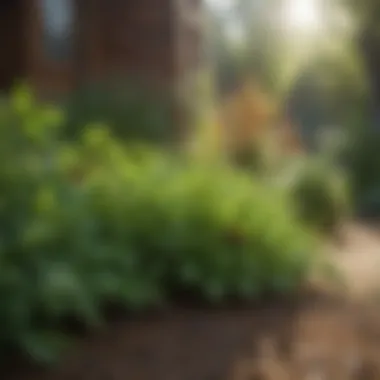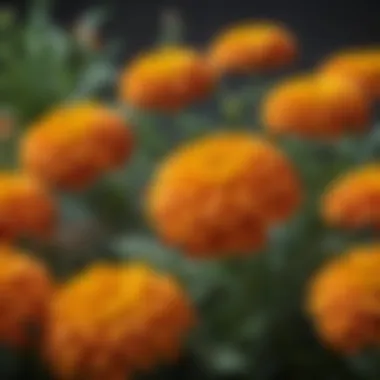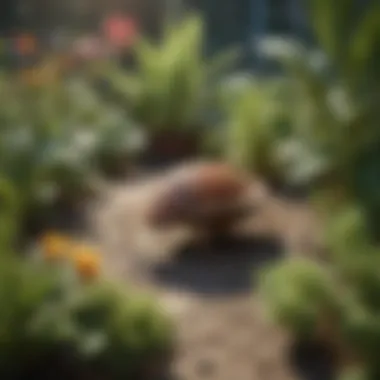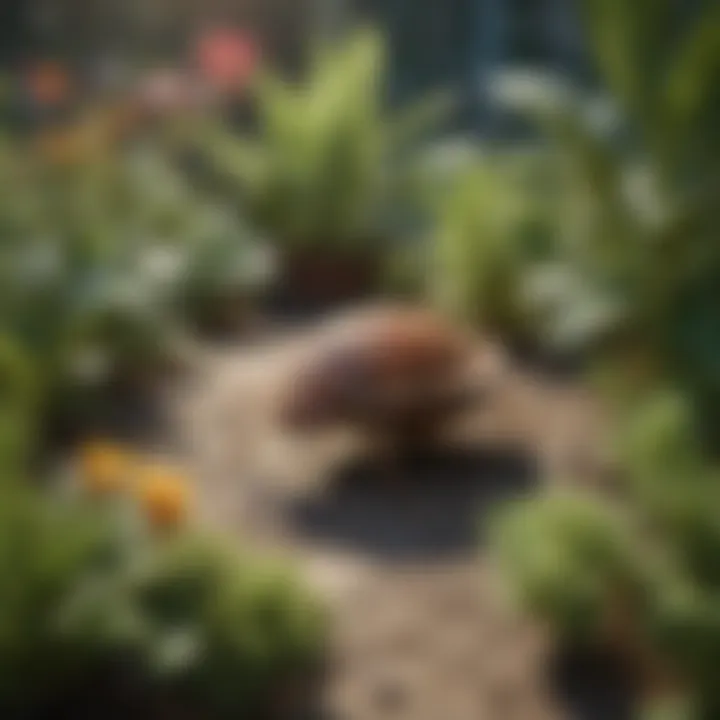Effective Plants for Deterring Stink Bugs


Intro
Stink bugs are a common nuisance in gardens and homes. They can cause damage to plants and create unpleasant odors, which can disrupt the gardening experience. Understanding how to manage these pests is essential for both aesthetic and practical reasons. The following sections will explore various plants that can effectively repel stink bugs, their benefits, and how to incorporate them into your pest management strategies.
Understanding Pests
Definition of Pests
Pests are organisms that can cause harm to plants, animals, and humans. They can include insects, rodents, and even weeds. In the context of home gardens, stink bugs are particularly problematic. These pests feed on a variety of plants, leading to reduced yields and damaged crops.
Importance of Pest Identification
Identifying specific pests like stink bugs is crucial for effective management. Knowing what you are dealing with enables you to select the right strategies and plants to deter them. Stink bugs belong to the family Pentatomidae. They are identifiable by their shield-shaped bodies and distinctive coloration.
Proper identification aids in understanding their habits, feeding patterns, and life cycles, which is key to finding effective control measures.
Prevention Techniques
Home and Garden Preventative Measures
Creating a pest-resistant environment starts at home. Here are some initial steps:
- Maintain a Clean Garden: Regularly remove debris and dead plants to reduce hiding spaces for stink bugs.
- Seal Entry Points: Check for cracks in windows, doors, and walls. Ensuring these areas are sealed helps prevent bugs from entering.
- Encourage Beneficial Insects: Certain insects like ladybugs can help keep stink bug populations in check.
Implementing these measures can significantly lower the chances of an infestation.
Seasonal Prevention Tips
Different seasons present unique challenges for stink bug management. During spring, cleaning and maintaining your garden becomes vital as these pests emerge from hibernation. In summer, monitor your plants closely, as this is when stink bugs are most active. In the fall, make sure to seal your home to prevent them from overwintering inside.
Eco-Friendly Pest Control Solutions
Overview of Sustainable Practices
Eco-friendly methods are essential for sustainable gardening. These practices include:
- Companion Planting: Planting certain species together can deter pests. Plants like marigolds and basil are known to repel stink bugs.
- Crop Rotation: Changing the types of plants grown in your garden each year can disrupt the life cycles of pests.
Such strategies reduce the use of chemical pesticides, which can be harmful to the ecosystem.
Natural Remedies and Their Effectiveness
Natural remedies can also be effective against stink bugs. Some options include:
- Essential Oils: Sprays made with essential oils, such as peppermint or clove, can deter stink bugs due to their strong scents.
- Soap Solutions: A mixture of water and soap can suffocate stink bugs upon contact.
These remedies provide an alternative to harsher chemicals, promoting a healthier garden environment.
"Opting for eco-friendly solutions not only protects plants but also ensures a safe and sustainable environment for you and your family."
Preface to Stink Bugs
Stink bugs are a common nuisance in many households, especially during warmer months. Understanding their behavior and impact on gardens is essential for effective pest management. Stink bugs feed on a variety of plants, causing significant damage to crops and ornamental gardens. These pests release a distinctive odor when disturbed, which is where their name comes from. This article aims to explore methods for keeping these pests at bay using specific plants.
Understanding Stink Bug Behavior
Stink bugs exhibit certain behaviors that can be understood to manage them effectively. They are most active in warm weather and attracted to gardens with tender foliage and fruits. These insects prefer to lay eggs on the undersides of leaves, making it essential for gardeners to keep an eye out for clusters of eggs.
When food sources become scarce, stink bugs may invade homes, seeking shelter for the winter. Their presence indoors can be alarming, as they can emit a foul smell when agitated. It is important to note that stink bugs are not harmful to humans or pets, but their impact on plants can lead to frustration for home gardeners.
Effective management begins with recognizing that prevention is easier than dealing with an established infestation. Creating an unwelcoming environment through strategic planting is a sensible approach.


Identifying Common Stink Bugs
To tackle the issue of stink bugs, proper identification is crucial. The most common types include the brown marmorated stink bug and the green stink bug.
- Brown Marmorated Stink Bug: This species is characterized by a brown, shield-like shape with distinct white bands on its antennae. They tend to be about three-quarters of an inch long and often invade homes in the fall.
- Green Stink Bug: Typically bright green, this bug also has a distinctive shield shape. It is slightly larger than its brown counterpart and often found on crops like tomatoes and peppers.
Other varieties exist, but these two are often the most problematic for gardeners. By learning to identify them, gardeners can more easily decide which plants may be effective in repelling these pests.
The Role of Plants in Pest Management
Pest management is a critical aspect of gardening that many homeowners often overlook. One important concept is the role of plants in controlling pest populations like stink bugs. Plants can serve as natural repellents and attract beneficial organisms that help with pest control. Understanding how to use plants effectively is key for anyone looking to create a healthy garden environment. This section will explore the elements that illustrate why the role of plants in pest management is vital.
Integrating specific plants into your garden can promote a balanced ecosystem. Not only do they repel unwanted pests, but they also attract natural predators such as ladybugs and lacewings. These beneficial insects can significantly reduce pest populations without the need for harsh chemicals. This natural balance is not just good for the plants but also supports broader environmental health.
Another critical factor is that certain plants emit volatile compounds that can deter stink bugs and other pests. When these plants are nearby, the insect's sensory perception may be disrupted and lead them to seek food sources elsewhere. This biological interaction can provide a sustainable solution to pest problems faced by homeowners.
Plant-Pest Interactions
The relationships between specific plants and pests are complex. Certain plants have evolved mechanisms that either attract pests towards them or repel them altogether. For instance, some plants produce nectar or pollen that draws beneficial insects while emitting substances that deter harmful species. Understanding these relationships can help gardeners select the right varieties to include in their gardens.
Some plants produce chemical defenses, which trigger behaviors in pests leading to avoidance. For example, herbs like basil or mint carry scents that can mask the host plants' aroma, making it difficult for stink bugs to locate their preferred feeding sources. This adaptation shows how plants play a proactive role in managing pest threats in their vicinity.
Companion Planting and Its Benefits
Companion planting is a technique that emphasizes pairing plants together for mutual benefit. This method can both maximize harvests and mitigate pest problems, particularly those posed by stink bugs. Planting compatible species next to one another can enhance growth, deter pests, or even attract beneficial insects that provide further protection.
Benefits of Companion Planting include:
- Natural Pest Deterrence: Certain combinations can create an environment that is hostile to pests.
- Biodiversity: This practice encourages a range of plants, improving the resilience of your garden.
- Soil Enrichment: Some plants can enhance soil quality, making nutrients more available to other plants in proximity.
- Aesthetic Appeal: Mixing different species can create a visually pleasing and diverse garden.
In summary, understanding the role of plants in pest management is essential for effective gardening practices. Integrating specific plant species can help home gardeners mitigate issues caused by stink bugs and create a thriving ecosystem. This not only preserves the health of your plants but also contributes positively to the environment.
Plants That Deter Stink Bugs
The use of specific plants as a natural barrier against stink bugs is increasingly recognized as an effective pest management strategy. These plants often emit scents or produce substances that are unappealing to these pests, thus acting as a deterrent. By incorporating these species into gardens, homeowners can minimize the presence of stink bugs while also enhancing the overall aesthetic of their spaces. This section explores various categories of plants that serve this purpose, focusing on herbs, flowering plants, and certain vegetables.
Aromatic Herbs
Basil
Basil is known for its strong aroma, which is a key factor in its ability to deter stink bugs. This herb is versatile and easy to grow, making it a popular choice among gardeners. Basil releases essential oils that stink bugs find undesirable, thus reducing their attraction to the area. Moreover, basil can be used in cooking, adding value beyond pest control.
A unique feature of basil is its variety; different types can be grown, each with specific flavors and aromas. However, it requires warm temperatures and adequate sunlight, which may limit its cultivation in cooler regions.
Thyme
Thyme is another aromatic herb that contributes effectively to stink bug management. Its small leaves and strong scent can repel these pests. Thyme is particularly charming in gardens due to its low-growing nature, lending to ground cover. This plant takes little maintenance, making it a good choice for busy homeowners.
The essence of thyme can vary in intensity between different varieties. A disadvantage might be its sensitivity to excessive moisture, which can hinder its growth and efficacy against pests.
Mint
Mint stands out for its vigorous growth and distinctive fragrance. Its scent is often cited as a natural insect repellent. Mint can form dense clusters, which not only help to deter stink bugs but also provide a refreshing addition to salads and teas.
Moreover, mint has a rapid growth rate which can sometimes be problematic; if not contained, it can quickly take over garden beds. This tendency requires careful management to prevent it from becoming invasive.
Flowering Plants
Marigolds
Marigolds are cherished in many gardens due to their bright colors and ability to repel pests. Their strong odor is off-putting to stink bugs and other insects. They are also known to attract beneficial insects, such as ladybugs, which provide more balanced pest control in the garden.
One unique factor with marigolds is their ability to thrive in a variety of soils, making them adaptable to different garden conditions. However, they may require replanting annually, as they are often treated as annuals.


Nasturtiums
Nasturtiums are both attractive and functional. They can deter stink bugs due to their natural oils and also serve as a trap crop. This means that these plants can attract bugs away from more valuable crops, drawing pests to them instead.
Additionally, nasturtiums are edible, offering vibrant flavors that can complement many dishes. One drawback is that they may need more attention regarding watering, particularly in dry periods to maintain their appearance and health.
Chrysanthemums
Chrysanthemums, also known as mums, are celebrated for their colorful blooms and pest-repelling abilities. They contain pyrethrum, a natural insecticide that can help manage stink bug populations effectively. This feature makes them a practical and attractive addition to any garden.
The wide variety of chrysanthemum types ensures that gardeners can find suitable ones for their specific aesthetic needs. Nevertheless, they can be sensitive to frost, possibly limiting their lifespan in cooler climates.
Repellent Vegetables
Tomatoes
Tomatoes serve a dual purpose; they are a pantry staple and can also help in pest management. The scent of tomato plants can repel stink bugs, while their lush foliage provides an attractive habitat for beneficial insects.
However, tomatoes do require moderate care, specifically concerning sunlight and watering, demanding attention to details for optimal growth. This may require dedication from gardeners.
Peppers
Peppers not only produce delicious fruits but also act as an effective deterrent to stink bugs. Similar to tomatoes, the aroma emitted by pepper plants seems unappealing to many pests. Growing peppers can also add spice to the culinary repertoire of any home cook.
One possible disadvantage is that different pepper varieties have varying levels of pest resistance, meaning that careful selection is necessary for success.
Radishes
Radishes are often overlooked in pest management discussions. However, they can deter stink bugs due to their sharp scent and taste. They also grow quickly, providing a fast return on investment for gardeners.
A downside is that radishes can be affected by poor soil conditions. Therefore, ensuring proper soil preparation is crucial for successful cultivation.
Incorporating these plants into your garden not only helps in managing stink bugs but also enhances the overall diversity and beauty of your garden.
Best Practices for Planting
When managing pests like stink bugs, planting the right flora is vital. Understanding best practices can significantly improve the effectiveness of your garden while creating a more balanced ecosystem. Proper planting not only deters unwanted pests but also enhances the overall health of plants. This results in more fruitful yields and a visually appealing garden. Below are crucial elements to consider when planting to keep stink bugs away.
Choosing the Right Location
Location is key when it comes to planting. Stink bugs prefer certain environments, so selecting the optimum area can make a difference. Look for spots with good sunlight, as many pest-repelling plants thrive in bright conditions. Avoid areas that retain too much moisture or are overly shaded, as dampness can attract pests.
It is also important to consider proximity to areas prone to infestation. If certain plants or crops in nearby gardens are known to attract stink bugs, avoid planting near them. By strategically placing your plants, you can create a natural barrier.
Soil Preparation for Optimal Growth
Preparing the soil is essential for the success of any garden. Healthy soil leads to robust plants that can better resist pests like stink bugs. Start by testing the soil pH; most plants thrive in slightly acidic to neutral pH levels. Amend the soil with organic matter, such as compost or well-rotted manure, to improve fertility.
Additionally, ensure proper drainage to prevent waterlogging, as wet conditions favor pests. Incorporate mulch around your plants to retain moisture and suppress weeds, but leave space to avoid creating a habitat for stink bugs.
Watering and Maintenance
Proper watering practices cannot be overlooked. Stink bugs are often attracted to wilting or stressed plants. It is essential to keep plants well-hydrated, especially during dry spells. However, overwatering can be just as harmful, leading to root rot that invites other pests.
Regular maintenance is also beneficial. Check plants frequently for signs of infestation. Removal of any stink bugs or eggs you find can prevent larger issues later. Furthermore, keep the garden tidy by removing debris and dead plant matter where pests may hide.
"Regularly monitoring your plants can help catch issues early and minimize pest problems."
In summary, implementing best practices for planting will not only deter stink bugs but also contribute to the sustainable health of your garden. Choose appropriate locations, prepare the soil adequately, and maintain your plants properly to create a flourishing environment that stands strong against pest populations.
Integrating Plants into Pest Management Strategies


Integrating plants into pest management strategies is crucial for homeowners seeking environmentally friendly approaches to control stink bugs. This integration involves understanding how various plants can work together to create a barrier against pests while promoting a healthy garden ecosystem. Effective integration is not merely about planting a few repellent species; it requires a thoughtful arrangement and selection of plants that can complement each other’s pest-repelling properties.
Benefits of Plant Integration
One significant benefit of integrating multiple plant species is the enhancement of overall effectiveness against pests like stink bugs. Certain combinations can deter insects better than single species can. For example, planting aromatic herbs alongside repellent vegetables can create a more diversified scent profile that confuses pests. When you combine plants with similar or complementary characteristics, they can provide a more robust defense.
Furthermore, using plants that attract beneficial insects can also be part of this strategy. These beneficial insects prey on stink bugs and other harmful pests, helping maintain a balanced ecosystem in the garden. Thus, integrating plants can create a self-regulating environment that reduces the reliance on chemical pesticides.
Considerations for Integration
When integrating plants into pest management strategies, consider the following elements:
- Plant Compatibility: Not all plants grow well together. Research companion planting to understand which species thrive in proximity.
- Diversity: A varied plant selection is less attractive to pests. A mono-crop can become a breeding ground for pests.
- Seasonality: Choose plants that offer seasonal presence. Some species might deter pests at certain times of the year while others may be more effective in another season.
- Climate Suitability: Select plants that are well-adapted to your local climate conditions to ensure better growth and survivability.
By thoughtfully integrating plants into pest management strategies, homeowners can create a holistic approach to controlling stink bugs while fostering a thriving garden environment.
Combining Multiple Plants for Enhanced Effectiveness
Combining multiple plants for enhanced effectiveness means leveraging the unique properties of different species to create a comprehensive pest management solution. This method is rooted in the principles of companion planting, where certain plants can enhance each other’s protective qualities.
- Aromatic herbs and vegetables: Mixing plants like basil and tomatoes not only improves the flavor but also deters stink bugs. The strong scent of basil can mask the scent of tomatoes, making them less attractive to these pests.
- Fragrant flowers: Planting marigolds alongside vegetables can deter various pests, including stink bugs, thanks to their natural insect-repelling properties.
- Insect-attracting plants: Include plants like yarrow or dill that attract beneficial insects such as ladybugs and lacewings. These insects can provide additional control over pest populations.
Creating a layered plant strategy ensures that even if one species fails to deter pests, another may take up the slack. Thus, combining multiple plants not only protects individual species but also contributes to the overall health of the garden.
Monitoring Pest Populations
Monitoring pest populations is a critical component of any integrated pest management strategy. Without proper tracking, it is challenging to assess the effectiveness of the chosen plants and practices. Regular monitoring can provide insights into population dynamics and help identify trends over time.
- Physical Inspection: Conduct regular checks in your garden for the presence of stink bugs and their signs, such as damage on plants. This should be a routine part of your gardening process.
- Use of Traps: Setting up simple traps, such as yellow sticky traps, can help in gauging pest presence. The number of stink bugs caught can guide you on when to take further action.
- Observe Beneficial Insects: Along with monitoring pests, keep an eye on beneficial insects. Their presence indicates a balanced ecosystem, which is a positive sign of effective plant integration.
Through consistent monitoring, homeowners can adapt their pest management strategies as needed. If one method isn’t working, adjustments can be made based on gathered data.
By carefully combining plants and maintaining vigilant monitoring, a robust strategy can be developed to deter stink bugs and promote garden health. This proactive approach not only enhances pest management but also fosters an appreciation for the natural interactions within the ecosystem.
Ecological Considerations
Understanding the ecological dynamics surrounding gardens is crucial for cultivating a harmonious environment that deters pests, such as stink bugs. The interplay between plants and their surrounding ecosystems informs various strategies for pest control, emphasizing the benefits of utilizing native, biodiverse plant species. Thus, this section will discuss the ecological aspects of using plants to manage stink bug populations, considering both the overall health of the garden and the implications for local ecology.
The Impact of Non-Native Plants
Non-native plants often disrupt local ecosystems. These species can outcompete native flora, leading to a loss of biodiversity that harms various beneficial insects like pollinators. When these plants dominate a garden, they may create an environment that is less favorable for natural predators of stink bugs, inadvertently fostering higher pest populations.
While introducing exotic species may initially appear attractive due to their potential aesthetic qualities or fast growth, the long-term impact can be detrimental. For example, plants like Japanese knotweed can overwhelm entire areas, taking over habitats that would otherwise support diverse species essential for ecological balance.
It's critical to choose plants wisely. Opting for native species not only supports local wildlife but also helps maintain a balanced ecosystem that can withstand pest invasions. Research suggests that native plants can also be more resilient to pests, reducing the need for chemical interventions altogether.
Promoting Biodiversity in Gardens
Promoting biodiversity in gardens serves multiple purposes. A varied plant selection not only enhances aesthetic appeal but also creates complex habitats for beneficial insects and other organisms. This ecological integrity helps regulate pest populations naturally, discouraging pests like stink bugs from establishing dominance.
Some effective practices include:
- Interplanting species: Mixing different types of plants can confuse pests and disrupt their life cycles.
- Creating inviting habitats: Incorporating a variety of plant heights and types fosters habitats for birds, beneficial insects, and other wildlife.
- Encouraging pollinators: Plants like coneflowers and milkweed attract pollinators, which are essential for a healthy garden ecosystem.
- Implementing rotational planting: Changing the locations of plants each season can minimize pest buildup and enhance soil health.
By understanding and implementing these practices, gardeners can enhance biodiversity, thereby creating a more robust and resilient ecosystem that effectively manages and deters pests.
"A diverse garden is not just more beautiful, it is more resilient to pests and diseases."
Closure
Understanding the role of specific plants in keeping stink bugs at bay is critical for homeowners and gardeners who wish to maintain a healthy and thriving garden environment. Employing these eco-friendly pest management strategies not only helps in reducing reliance on chemical pesticides but also fosters a sustainable interaction with nature.
Summarizing Key Takeaways
- Diverse Plant Selection: Incorporating a range of plants like aromatic herbs and flowering plants proves beneficial in repelling stink bugs. Plants such as basil and marigolds showcase excellent deterrent properties.
- Companion Planting: This method enhances the effectiveness of guardian plants, as different species can cooperate to ward off pests. Pairing plants strategically can create a robust defense against stink bugs.
- Ongoing Maintenance: Regular monitoring of plant health and pest populations is necessary. This includes observing changes in plant condition and being aware of variations in stink bug presence.
"Utilizing plants for pest management is not merely about aesthetics; it plays a crucial role in environmental stewardship."
Looking Ahead: Future Pest Management Trends
The future of pest management is leaning towards more integrated approaches that respect natural ecosystems. Growing awareness about the environmental impact of chemical pesticides is encouraging homeowners to adopt alternative practices. As research continues to unveil new insights about plant-pest interactions, homeowners can expect novel plant varieties to emerge, specifically bred for pest repellency. Additionally, there is potential for digital tools in tracking garden ecosystems
Adopting a holistic view of pest management may become essential, helping to not only repel stink bugs but also promote biodiversity within garden spaces. Understanding this relationship between plants and pests can significantly affect gardening practices and outcomes moving forward.



